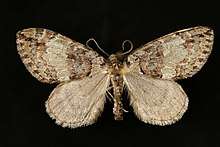Hydriomena irata
Hydriomena irata is a species of geometrid moth in the family Geometridae.[1][2][3][4][5] It is found in North America.[1]
| Hydriomena irata | |
|---|---|
 | |
| Scientific classification | |
| Kingdom: | Animalia |
| Phylum: | Arthropoda |
| Class: | Insecta |
| Order: | Lepidoptera |
| Family: | Geometridae |
| Genus: | Hydriomena |
| Species: | H. irata |
| Binomial name | |
| Hydriomena irata Swett, 1910 | |
Subspecies
These three subspecies belong to the species Hydriomena irata:
- Hydriomena irata irata g
- Hydriomena irata lolata McDunnough, 1954 c g
- Hydriomena irata quaesitata Barnes & McDunnough, 1918 c g
Data sources: i = ITIS,[1] c = Catalogue of Life,[2] g = GBIF,[3] b = Bugguide.net[4]
gollark: This isn't actually possible.
gollark: Do you mean the discussion of baidicoot being banned, or...?
gollark: * take quite long
gollark: I'm working on it. It may be quite long.
gollark: Probably the jwinslow thing?
References
- "Hydriomena irata Report". Integrated Taxonomic Information System. Retrieved 2018-03-30.
- "Hydriomena irata species details". Catalogue of Life. Retrieved 2018-03-30.
- "Hydriomena irata". GBIF. Retrieved 2018-03-30.
- "Hydriomena irata Species Information". BugGuide.net. Retrieved 2018-03-30.
- "Hydriomena irata Overview". Encyclopedia of Life. Retrieved 2018-03-30.
- "North American Moth Photographers Group, Hydriomena irata". Retrieved 2018-03-30.
Further reading
- Beadle, David; Leckie, Seabrooke (2012). Peterson Field Guide to Moths of Northeastern North America. Virginia Museum of Natural History. ISBN 0547238487.
- Covell, Charles V. Jr. (2005). A Field Guide to Moths of Eastern North America. Special Publication Number 12. Virginia Museum of Natural History. ISBN 1-884549-21-7.
- Grote, Aug.R.; Robinson, C.T. (1868). List of the Lepidoptera of North America. American Entomological Society.
- Heppner, J.B. (2003). "Lepidoptera of Florida. Part 1. Introduction and catalog" (PDF). Arthropods of Florida and Neighboring Areas. Florida Department of Agriculture and Consumer Services. 17. ISSN 0066-8036. Archived from the original (PDF) on 2018-04-23. Retrieved 2018-03-31.
- Hodges, Ronald W., ed. (1983). Check List of the Lepidoptera of America North of Mexico: Including Greenland. E.W. Classey and The Wedge Entomological Research Foundation. ISBN 9780860960164.
- Holloway, J.D. (1997). Family Geometridae, subfamilies Sterrhinae and Larentiinae. The Moths of Borneo. part 10. Southdene Sdn. Bhd. ISBN 983999154X.
- Pohl, Greg; Patterson, Bob; Pelham, Jonathan (2016). Annotated taxonomic checklist of the Lepidoptera of North America, North of Mexico (Report). doi:10.13140/RG.2.1.2186.3287.
- Powell, Jerry A.; Opler, Paul A. (2009). Moths of Western North America. University of California Press. ISBN 9780520251977.
- Viidalepp, Jaan (2006). "Cladistic analysis of the subfamily Larentiinae". Spixiana. 29 (3): 202–203. ISSN 0341-8391.
- Yamamoto, Satoshi; Sota, Teiji (2007). "Phylogeny of the Geometridae and the evolution of winter moths inferred from a simultaneous analysis of mitochondrial and nuclear genes". Molecular Phylogenetics and Evolution. 44: 711–723. ISSN 1055-7903.
This article is issued from Wikipedia. The text is licensed under Creative Commons - Attribution - Sharealike. Additional terms may apply for the media files.